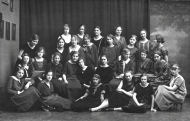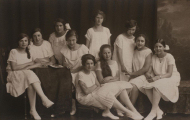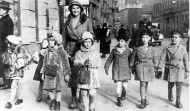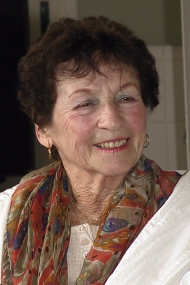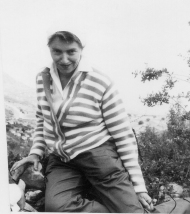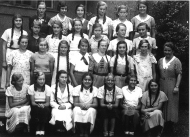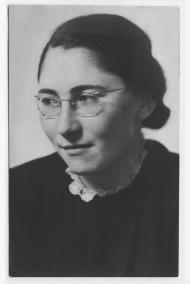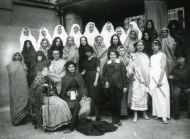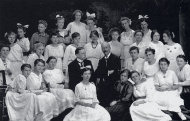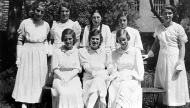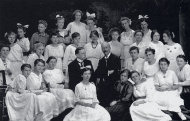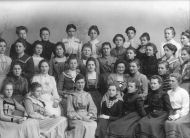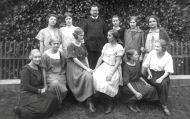|
|
|
|
|
|
|
|
|
|
|
|
|
|
|
|
|
|
|
|
|
|
|
|
|
|
|
|
|
|
|
|
|
|
|
|
|
|
|
|
|
|
|
|
|
|
|
|
|
|
|
|
|
|
|
|
|
|
|
|
|
|
|
|
|
|
|
|
|
|
|
|
|
|
|
|
|
|
|
|
|
|
|
|
|
|
|
|
|
|
|
|
|
|
|
|
|
|
|
|
|
|
|
|
|
|
|
|
|
|
|
|
|
|
|
|
|
|
|
|
|
|
|
|
|
|
|
|
||||||||||||||||||||||||||||||||||||||||||||||||||||||||||||||||||||||||||||||||||||||||||||||||||||||||||||||
|
|
Elsa Waitzfelder Born: 1906 in Augsburg. Father’s occupation: businessman. Elsa’s parents were Bernhard Waitzfelder (b. 1875 in Augsburg) and Karoline, née Levy (b. 1882 in Augsburg). Bernhard was a co-owner of the leather wholesale company “Bacharach & Waitzfelder”. Elsa had two brothers, Jacques (1904–84) and Kurt (1911–58). Elsa attended Maria-Theresia-School from 1916 to 1920 in classes 1–4; perhaps she remained at the school until 1922 and attended classes 5 and 6 as well. In 1921, Elsa celebrated her “confirmation” in Augsburg, together with six other Jewish girls (Bat Mitzvah: the feast of religious majority for Jewish girls, which can be celebrated individually on the Sabbath after a girl’s 12th birthday; in Augsburg, however, it was held annually or even after longer intervals for several age groups together, similar to the Protestant confirmation). In 1928, Elsa married Dr. Erwin Meyer (or Mayer) from Berlin. She died during the same year. Elsa’s parents had to move to 14 Hallstraße around 1942. The National Socialists established a “Jewish house” (“Judenhaus”) at that place. Bernhard and Karoline were deported to Piaski, Poland, in the beginning of April 1942. They are considered missing. Elsa’s elder brother, Jacques, graduated in economics and law. In 1929, he published a book on Johann Heinrich von Schüle, a famous cotton manufacturer in Augsburg in the 18th century; Jacques dedicated the book to the memory of his sister. In 1933, he was admitted to the bar in Munich, but the National Socialists more and more prohibited Jewish lawyers to practise. Jacques emigrated to the USA in 1938, where he changed his name to Whitfield. He worked for chemical companies. |
Elsa’s younger brother, Kurt, married Ruth Hirschfeld. The couple emigrated to the USA in 1942 at the latest. Sources and further reading: Jacques Waitzfelder, Der Augsburger Johann Heinrich von Schüle, ein Pionier der Textilwirtschaft im 18. Jahrhundert, Leipzig, 1929. Reinhard Weber, Das Schicksal der jüdischen Rechtsanwälte in Bayern nach 1933, Munich, 2006, p. 264 (on Jacques/Jakob Waitzfelder). |
|
Anni Wallach Born: 1909 in Cologne. Father’s occupation: businessman, manufacturer. Anni’s parents were Jakob Wallach and Paula, née Heilbronner (b. 1887 in Augsburg). They got divorced. Anni (or “Anny”) attended Maria-Theresia-School from 1919 to 1925 in classes 1–6. Anni’s mother, Paula, had to move to 5½ Mozartstraße in 1939. The National Socialists established a “Jewish house”(“Judenhaus”) at that place. In the beginning of April 1942, Paula was deported to Piaski, Poland. |
|
Ruth Wallach Born: 1911 in Düsseldorf. Father’s occupation: managing director in Augsburg. Ruth’s parents were Simon Wallach (b. 1880 in Cologne) and Hedwig (b. 1875 in Braunschweig). Simon was a director of several machine companies. Ruth had a younger brother, Rolf (b. 1916). Ruth attended Maria-Theresia-School from 1924 to 1927 in classes 4–6; presumably, she had joined the school in 1921 in class 1. In May 1925, Ruth celebrated her “confirmation” in Augsburg, together with nine other Jewish girls (Bat Mitzvah: the feast of religious maturity for Jewish girls, which can be celebrated individually on the Sabbath after a girl’s twelfth birthday; in Augsburg, however, it was held annually or even after longer intervals for several age groups together, similar to the Protestant confirmation). Ruth married Eugen Grünhut from Augsburg (b. 1909). (Eugen was a nephew of Adele Mendelsohn, née Grünhut, the mother of Fanny Mendelsohn.) The couple had one daughter. Ruth’s uncle MD Moritz (Moshe) Wallach (b. 1866 in Cologne) had transferred to Jerusalem in 1892. He was the senior consultant of “Shaare Zedek” hospital. Due to this connection, many members of the Wallach family were able to emigrate to Palestine in the 1930s. Ruth and Eugen did so in 1936. Ruth’s parents transferred to Mannheim in 1932. They also emigrated to Palestine in 1936. Simon died in Jerusalem in 1950, Hedwig in Haifa in 1960. Ruth’s brother, Rolf, also emigrated to Palestine. He returned to Germany, together with his wife and two sons, in 1956. He died in 1990. Ruth Grünhut, née Wallach, died in Haifa before 2006. |
|
Hilde Waluta Born: 1926 in Augsburg (no place of birth is given in the Annual School Reports). Father’s occupation: Authorized Commercial Signator. Hilde’s parents were Alfred Waluta (b. 1899 in Vienna) and Ilse, née Herrmann (b. 1904 in Gotha). Alfred worked as an authorized commercial signator at the wholesale company of grain owned by Franz Schwarz, the father of Ilse Schwarz. Hilde attended Maria-Theresia-School in 1937 and 1938 in classes 1b and 2b. Twelve-year-old Hilde left the school on May 28, 1938, at the beginning of the second grade. In the same year, she emigrated to Cali, Columbia, together with her parents. In Cali, Hilde’s father, Alfred, became a co-owner of a comb factory. Hilde married Hans Zander from Berlin. The couple had four children. |
|
|
Margarete Wassermann Born: 1921 in Augsburg (no place of birth is given in the Annual School Reports). Father’s occupation: businessman. Store: Bahnhofstraße, at the corner of Burgkmairstraße. Margarete’s parents were Karl Wassermann (b. 1877 in Ulm) and Jenny, née Pflaunlacher (b. 1890 in Augsburg). The production plant of Karl Wassermann’s firm “Pflaunlacher & Schwab, Sportswear” was on Haunstetter Straße. Margarete had an elder brother, Heinz (1914–88). Margarete’s maternal aunt Berta Schwab, née Pflaunlacher, was married to Max Schwab. Max was another co-owner of the company “Pflaunlacher & Schwab”. Max’s daughters, Liselotte and Paula Schwab, were cousins of Margarete. Initially, Margarete and her family lived on Bismarckstraße, then Volkhartstraße, Völkstraße, Frohsinnstraße (the apartment house was turned into a Jewish old people’s home in 1937) and, finally, at 14 Hallstraße. Around 1942, this apartment house was made into a “Jewish House” (“Judenhaus”) by the National Socialists, the apartments were split up further with, among others, Marianne and Gertrud Weil and their mother living in a very confined space until their deportation to Auschwitz in March 1943. The “German Empire” (“Deutsches Reich”) became owner of the house. In 1944, the house was burned out due to an air raid. After the war, a settlement was reached between the German state and the heirs of the former owners, and a new house was built. Margarete went to Maria-Theresia-School from 1931 to 1937 in classes 1–G6. In Berlin, she trained to become a fashion illustrator. Margarete’s father was dispossessed and incarcerated in November 1938 for some time. Her brother emigrated to the USA that year. Margarete emigrated to England in 1939 and worked there as a nurse. In 1942, she married Herbert Berlin |
|
Edith Weil Born: 1924. Father’s occupation: businessman in Augsburg. Flat: 15 Alpenstraße. Edith’s parents were Hermann Weil (b. 1883 in Buchau at Federsee) and Selma, née Oberdorfer (b. 1893 in Hainsfarth). Edith had an elder brother, Leo (b. 1922). Hermann’s elder brother, Siegfried—the father of Gertrud and Marianne Weil—, as well as his younger brother, Julius (b. 1887), also had settled in Augsburg. Hermann and Siegfried were the owners of a company for the manufacture of agricultural machinery in Pfersee, a district of Augsburg (“Motoren- und Maschinenfabrik Augsburg-Pfersee”). In 1931, the firm had to be sold due to debts and—according to Siegfried’s son, Arie Weil—also due to political reasons (interview in 2005). Edith attended Maria-Theresia-School from 1935 to 1938 in classes 1–4. At the age of almost fourteen years, Edith was forced by Government decree to leave the school on November 14, 1938, without graduation. Edith’s father and—a little bit later— Edith herself emigrated to the Netherlands in 1938. Hermann had to live in an internment camp until 1940. Edith joined an educational camp in Wieringen, where young Jews were prepared for their emigration to Palestine. Later, she worked for the Jewish council in Amsterdam. “Upon German demand, this organisation had to list the Jews deemed for deportation. Therefore, Edith herself was understood to be exempted from deportation” (G. Römer, An meine Gemeinde in der Zerstreuung). According to Edith’s brother, Leo, Hermann and Edith declined his offer to smuggle them to France because they thought that they were safefrom deportation. In December 1943 or January 1944, however, Hermann and Edith were deported from Amsterdam to Auschwitz, where they are said to have been killed on January 28, 1944. |
|
|
|
Erna Weil Born: 1907 in Augsburg. Father’s occupation: businessman. Flat and company: D 139 (today’s No. 2) Hafnerberg. Erna’s father, Emil Weil (b. 1874 in Augsburg), was a leather merchant. Her mother was Bella, née Sundheimer (b. 1879 in Regensburg). Emil was a co-owner of the wholesale business of leather “Leopold Weil & Cie”. Like Erna, her older sister, Liselotte, also attended Maria-Theresia-School. Erna is described as an exceptionally talented pupil. She attended Maria-Theresia-School from 1917 to 1926 in classes 1–G9. In 1921, Erna celebrated her “confirmation” in Augsburg, together with her sister, Liselotte, and five other Jewish girls (Bat Mitzvah: the feast of religious majority for Jewish girls, which can be celebrated individually after a girl’s twelfth birthday; in Augsburg, however, it was held annually or even after longer intervals for several age groups together, similar to the Protestant confirmation). Erna graduated in March 1926. First she studied medicine for one term in Vienna, then in Munich, where she passed the medical state exam at the end of 1931. She completed her practical year in Augsburg, Hamburg and Berlin; in Augsburg she worked in the internal medicine department of the municipal hospital for four months under the supervision of Prof. Friedrich Georg Port. After the burning of the Reichstag in 1933, she lost her employment in Berlin. In the following year she enrolled in Turin to take another state exam, which would be accepted in Great Britain; Lotte Dann, the younger sister of her school friend Elisabeth Dann, joined her. However, through the anti-Jewish politics in Italy she was prevented from taking the exam and returned to Germany, where she worked as a nurse at a Jewish hospital in Frankfurt on Main. In 1938, Erna’s mother, Bella, escaped to Montreux, Switzerland, and was followed by her husband, Emil, in 1939. From there Emil emigrated to the USA in |
|
|
|
Gertrud Weil Born: 1920 in Augsburg (the place of birth is not mentioned in the Annual School Reports). Father’s occupation: engineer. Flat: 20 Klinkerberg. Gertrud’s father, Siegfried Weil (b. 1878), came from Buchau at Federsee (Württemberg). As a mechanical engineer he came to Augsburg in 1910 and bought a company for the manufacture of agricultural machinery in Pfersee, a district of Augsburg, at 40 Leitershoferstraße. His younger brothers, Hermann (the father of Edith Weil) and Julius (b. 1879), also settled in Augsburg; Hermann was a co-owner of the company. In 1919, Siegfried married. His wife, Amalie, “Mali”, née Lamm (b. 1895), came from Nuremberg and worked as an artist (painting in oil) until her marriage. Like Gertrud, her younger sister, Marianne, also attended Maria-Theresia-School. The girls had a younger brother, Alfred (“Arie”, b. 1925). In 1931, Siegfried Weil was forced to sell his firm due to debts. His son, Arie, is convinced that this misfortune was due also to political reasons (interview in 2005). Siegfried became a representative of various firms which sold carpentry products. He died of an illness at the age of sixty on September 7, 1938. Gertrud, the first child of the couple, attended Maria-Theresia-School from 1930 to 1935 in classes 1–5. In 1935, Gertrud celebrated her “confirmation” in Augsburg, together with other Jewish girls (Bat Mitzvah: the feast of religious majority for Jewish girls, which can be celebrated after a girl’s twelfth birthday; in Augsburg, however, it was held annually or even after longer intervals for several age groups at the same time). The singer Dina Marx, née Strauss, contributed to the programme. After completing school, Gertrud trained as a nurse at a Jewish children’s home in Munich. As of 1936 she worked at a Jewish nursery in Berlin, from 1939 on for a Jewish doctor in Augsburg. |
On October 28, 1940, Gertrud married, via a long distance marriage ceremony, the sweetheart from her youth, Ernst Günzburger (b. 1916 in Augsburg). Ernst had emigrated to Brazil in 1937, when Gertrud hadn’t yet finished her education. (Thea Günzburger was Ernst’s sister.) However, Gertrud was not allowed to emigrate. At the family’s flat on Klinkerberg at last there also lived Gertrud’s paternal grandmother, Julie Weil (b. 1855). She was deported to Terezin on July 31, 1942, where she died after less than two weeks. In 1942, together with her mother and sister Marianne, Gertrud was relocated to a small room in a so-called “Jewish house” (“Judenhaus”) in Hallstraße 14. The three women were deported to Auschwitz at the beginning of March 1943. There Gertrud nursed invalids and died of typhoid fever in July 1943. Presumably, her mother and sister had died by then; they were pronounced dead in 1946. Arie, Gertrud’s brother, could emigrate to Palestine in 1939. Up to this day he lives in Israel (May 2008). He assisted us in completing our project “Spurensuche”. Gertrud’s uncle Julius Weil was married to a Christian woman. He survived the war doing forced labour and died in Augsburg in 1947. The name of Gertrud Günzburger is listed on a glass plaque at the shoah memorial which can be visited in Augsburg’s City Hall (Artist: Klaus Goth). Sources and further reading: Renate Weggel, “Nicht Stadt, nicht Dorf. Industrialisierung in Pfersee und die Folgen,” Geschichtswerkstatt Augsburg e. V., ed., Nicht Stadt, nicht Dorf. Leben und Arbeiten in Pfersee. Dokumentation und Ausstellung, Augsburg, 1994, pp. |
1–21, p. 6 (advertisement of S. & H. Weil’s “Motoren- u. Maschinenfabrik Augsburg-Pfersee”). Renate Weggel, Pfersee: Dorf—Industrieort—Vorort. Die Industrialisierung und ihre Auswirkungen auf eine Gemeinde vor den Toren Augsburgs, Augsburg, 1995, pp. 32–33 (on the firm “Gebrüder Demharter”, which Siegfried Weil bought in 1910). Walter Gerlach, ed., Das Buch der alten Firmen der Stadt und des Industriebezirkes Augsburg im Jahre 1930, Leipzig, 1930, p. 75 (advertisement of S. & H. Weil’s company). Sofia Dratva, “Geschichte der Familie Weil,” Peter Wolf, ed., Spuren. Die jüdischen Schülerinnen und die Zeit des Nationalsozialismus an der Maria-Theresia-Schule Augsburg. Ein Bericht der Projektgruppe “Spurensuche” des Maria-Theresia-Gymnasiums, Augsburg, 2005, pp. 38–42; for an updated version, see the German part of this website, chapter “Biografien” —>“Familie S. Weil”. Gernot Römer, Die Austreibung der Juden aus Schwaben. Schicksale nach 1933 in Berichten, Dokumenten, Zahlen und Bildern, Augsburg, 1987, pp. 171–76. Regina Scheer, Ahawah. Das vergessene Haus. Spurensuche in der Berliner Auguststraße, Berlin, 1992; 4th edition, 2004, esp. pp. 222–42 (on a Jewish nursery in Berlin). |
Liselotte Weil Born: 1906 in Augsburg. Father’s occupation: businessman. Flat and company: D 139 (today’s No. 2) Hafnerberg. Liselotte’s father, Emil Weil (b. 1874 in Augsburg), was a leather merchant. Her mother was Bella, née Sundheimer (b. 1879 in Regensburg). Emil was a co-owner of the wholesale business of leather “Leopold Weil & Cie”. Like Liselotte, her younger sister, Erna, also attended Maria-Theresia-School. Liselotte attended Maria-Theresia-School from 1916 to 1920 in classes 1–4; perhaps she remained at the school until 1921/22 and completed the sixth grade in 1922. In 1921, Liselotte celebrated her “confirmation” in Augsburg, together with her sister, Erna, and five other Jewish girls (Bat Mitzvah: the feast of religious majority for Jewish girls, which can be celebrated individually after a girl’s twelfth birthday; in Augsburg, however, it was held annually or even after longer intervals for several age groups at the same time, similar to the Protestant confirmation). Liselotte married Stefan Oberbrunner (b. 1901 in Nuremberg), a lawyer. In 1932, a daughter was born to them. The family emigrated to France in 1934. Stefan worked at a photographic shop and had other jobs as well. In 1939, he joined the French army; in the next year, he was interned. In March 1943, he was deported from the transition camp in Drancy to Majdanek, Poland. He is considered missing. In 1938, Liselotte’s mother, Bella, escaped to Montreux (Switzerland), followed by her husband, Emil, in 1939. From there Emil emigrated to the USA in 1940. At the end of the year, Bella gave notice of change in residence to the City Registry, with unknown destination; apparently, she was able to flee with her husband to New York City. Emil died there in 1946. |
Early in 1941, Liselotte’s sister, Erna, stayed with her for a while and later emigrated to the USA. In 1941 or 1942, Liselotte and her daughter, Anne, also could emigrate to the USA. Liselotte worked as a milliner. Liselotte Oberbrunner, née Weil, died in 1991 in Koloa, Kauai, Hawaii. Sources and further reading: Gernot Römer, ed., “An meine Gemeinde in der Zerstreuung.” Die Rundbriefe des Augsburger Rabbiners Ernst Jacob 1941–1949, Augsburg, 2007, p. 322. Gedenkbuch für die Nürnberger Opfer der Schoa. With an essay by Leibl Rosenberg, ed. Michael Diefenbacher and Wiltrud Fischer-Pache, prepared by Gerhard Jochem and Ulrike Kettner, Nuremberg, 1998, p. 251 (on Stefan Oberbrunner, No. 1489). Reinhard Weber, Das Schicksal der jüdischen Rechtsanwälte in Bayern nach 1933, Munich, 2006, p. 249 (on Stefan Oberbrunner). Monika Ebert, Zwischen Anerkennung und Ächtung. Medizinerinnen der Ludwig-Maximilians-Universität in der ersten Hälfte des 20. Jahrhunderts, Neustadt an der Aisch, 2003, pp. 221–23 (on Erna Weil). |
|
|
Marianne Weil Born: 1922 in Augsburg (place of birth is not mentioned in the Annual School Reports). Father’s occupation: engineer. Flat: 20 Klinkerberg. Marianne’s father, Siegfried Weil (b. 1878), came from Buchau at Federsee (Württemberg). As a mechanical engineer he came to Augsburg in 1910 and bought a company for the manufacture of agricultural machinery in Pfersee, a district of Augsburg, at 40 Leitershoferstraße. His younger brothers, Hermann (the father of Edith Weil) and Julius (b. 1879), also settled in Augsburg; Hermann was a co-owner of the company. In 1919, Siegfried married. His wife, Amalie, “Mali”, née Lamm (b. 1895), came from Nuremberg and worked as an artist until her marriage (painting in oil). Like Marianne, her older sister, Gertrud, also attended Maria-Theresia-School. The girls had a younger brother, Alfred (“Arie”, b. 1925). In 1931, Siegfried Weil was forced to sell his firm due to debts. His son, Arie, is convinced that this misfortune was due also to political reasons (interview in 2005). Siegfried became a representative for various firms which sold cabinetmaking products. He died of an illness at the age of sixty on September 7, 1938. Marianne’s school life began at the age of six in St-Anna-School. On April 7, 1932, she went on to Maria-Theresia-School, which she attended from 1932 to 1938 in classes 1–4 and L5–L6 (“L” meaning “Lyzeum”, a branch of the secondary school as opposed to the more demanding “Gymnasium”). Marianne had excellent marks and was a talented graphic artist. Marianne was one of nine Jewish girls (among them also Auguste Wolf and Johanna Landmann) who celebrated their “confirmation” in Augsburg in May 1937. (Bat Mitzvah: Ceremony of religious majority for Jewish girls, can be celebrated individually on the Sabbath after a girl’s 12th birthday or, as in |
Augsburg, annually or even in larger intervals for several age groups together, similar to the confirmation of Protestants.) The singer Dina Marx, née Strauss, contributed to the programme. During the first two years at Maria-Theresia-School, Elisabeth Lang from Ederheim (Ries) was Marianne’s classmate. Elisabeth, whose married name was Wolf, published her memoirs in 1997. In her book she tells about several teachers who had a hostile attitude toward National Socialism. Dr. Otto Feller, for instance, a German teacher, when going through genealogy, declared that Marianne’s family tree was the best and had it go round the class. Therefore, he was denounced by the father of another girl. In a talk with the team of the “Spurensuche”, Otto Feller’s daughter confirmed that incident. According to Elisabeth Wolf, the art teacher Lilly Premauer particularly looked after Marianne. The Private Tennis Association, Augsburg, a Jewish sports club, used wood engravings of Marianne for the winner’s certificates of the youth competitions in 1937 and 1938. Those were the last events of that kind; thereafter, the club was expropriated. In 1938, Marianne received her secondary school certificate (“Mittlere Reife”) at Maria-Theresia-School and then went on to study graphics at the Augsburg School of Arts until 1940. In the spring of 1940, she caused a scandal because during a test she handed in a picture which was a seven-arm-candleholder, a symbol of Judaism. Marianne was expelled from the school. From September 1941 on, Marianne worked as a forewoman at the Augsburg Balloon Factory, where many Jewish women and girls had to do forced labour. At |
that time the workshops were located at the Augsburg Spinning Mill (“Augsburger Kammgarnspinnerei”). At the family’s flat on Klinkerberg at last there also lived Marianne’s paternal grandmother, Julie Weil (b. 1855). She was deported to Terezin on July 31, 1942, where she died after less than two weeks. In 1942, Marianne was relocated to a small room, together with her mother and her sister Gertrud, to a so-called “Jewish house” (“Judenhaus”) in Hallstraße 14. The three women were deported to Auschwitz at the beginning of March 1943. In 1946, Marianne and her mother were pronounced dead and Gertrud in 1947. Arie, Marianne’s brother, could emigrate to Palestine in 1939. Up to this day he lives in Israel (May 2008). He assisted us in completing our project “Spurensuche”. Marianne’s uncle Julius Weil was married to a Christian woman. He survived the war doing forced labour and died in Augsburg in 1947. The name of Marianne Weil is listed on a glass plaque at the shoah memorial which can be visited in Augsburg’s City Hall (artist: Klaus Goth). Sources and further reading: Stiftung Jüdisches Kulturmuseum Augsburg-Schwaben, ed., Ein fast normales Leben. Erinnerungen an die jüdischen Gemeinden Schwabens. Ausstellung der Stiftung Jüdisches Kulturmuseum Augsburg-Schwaben nach einem Konzept von Gernot Römer, Augsburg, 1995, p. 119 (a wood engraving with dedication by Marianne Weil) and p. 158 (certificates of the Private Tennis Association, Augsburg, with wood engravings by Marianne Weil). |
Renate Weggel, “Nicht Stadt, nicht Dorf. Industrialisierung in Pfersee und die Folgen,” Geschichtswerkstatt Augsburg e. V., ed., Nicht Stadt, nicht Dorf. Leben und Arbeiten in Pfersee. Dokumentation und Ausstellung, Augsburg, 1994, pp. 1–21, esp. p. 6 (advertisement of S. and H. Weil’s factory, “Motoren- u. Maschinenfabrik Augsburg-Pfersee”). Renate Weggel, Pfersee: Dorf—Industrieort—Vorort. Die Industrialisierung und ihre Auswirkungen auf eine Gemeinde vor den Toren Augsburgs, Augsburg, 1995, pp. 32–33 (on the firm “Gebrüder Demharter”, which Siegfried Weil bought in 1910). Walter Gerlach, ed., Das Buch der alten Firmen der Stadt und des Industriebezirkes Augsburg im Jahre 1930, Leipzig, 1930, p. 75 (advertisement of S. & H. Weil’s company). Sofia Dratva, “Geschichte der Familie Weil,” Peter Wolf ed., Spuren. Die jüdischen Schülerinnen und die Zeit des Nationalsozialismus an der Maria-Theresia-Schule Augsburg. Ein Bericht der Projektgruppe “Spurensuche” des Maria-Theresia-Gymnasiums, Augsburg, 2005, pp. 38–42; for an updated version, see the German part of this website, chapter “Biografien” —> “Familie S. Weil”. Eugen Nerdinger, Brüder, zum Licht empor. Ein Beitrag zur Geschichte der Augsburger Arbeiterbewegung, Augsburg, 1984, p. 239. Gernot Römer, Die Austreibung der Juden aus Schwaben. Schicksale nach 1933 in Berichten, Dokumenten, Zahlen und Bildern, Augsburg, 1987, pp. 171–76. Elisabeth Wolf, Der Funke Ewigkeit. Eine Familienchronik, Berlin, 1997, pp. 114–17 and 236. |
Gertrud Wiesenthal Born: 1923. Father’s occupation: businessman in Augsburg. Gertrud’s father, Siegfried Wiesenthal (b. 1892), was Jewish, her mother, Katharina (“Käte”), née Gleich (b. 1899), was a Catholic. Käte had also visited Maria-Theresia-School. In 1919, the couple married. Siegfried managed the shipping department of the Farbwerke corporation, which was located in Gersthofen, near Augsburg. (From 1925 on, the firm was called “IG Farben”.) Gertrud had a brother, Fritz. The children were both baptized as Catholics, initially, however, religion was irrelevant to the family. Siegfried withdrew from the Jewish community in 1931. Only after a serious illness Gertrud’s mother became religious; impressed by that, her father let himself be baptized a Catholic in 1935. Gertrud attended Maria-Theresia-School from 1933 to 1936 in classes 1–3. She disliked a teacher who was a National Socialist, and she wasn’t satisfied with the marks awarded in two subjects. Consequently, she transferred to St. Elisabeth, a convent school run by the Franciscan nuns of the convent “Maria Stern”, where she felt much better. After the November Pogrom in 1938, Siegfried Wiesenthal was taken to the concentration camp in Dachau. As a combatant of the First World War he was released after a few weeks. The emigration of the family (without Fritz, who stayed in Germany) to the USA via Rotterdam failed. Under the most difficult circumstances (razzia of the Gestapo, escape, detainment in the Westerbork concentration camp, forced labour) the family survived the war in the Netherlands. Westerbork was a camp for Jewish refugees in the Netherlands. Siegfried Wiesenthal was interned there in 1940. His wife and his daughter followed him voluntarily; afterwards, however, they were not allowed to leave the camp any more. In the summer of 1942 the Germans took over the camp and turned it into a |
transit camp under police surveillance (“polizeiliches Durchgangslager”). From here, the SS deported the Jews from the Netherlands to the extermination camps in Eastern Europe. As Siegfried was married to a non-Jewish woman, the family was dismissed from the camp in July 1942. They settled in Amsterdam. Later, however, Siegfried had to spend another four weeks in Westerbork. After the war, the family lived in Gersthofen and Augsburg. Gertrud worked as a Master Dressmaker, her brother Fritz became Prosecutor and Chief Administrative Officer of the Augsburg district. Siegfried Wiesenthal died in 1951, the widowed Käte in 1981. Up to this day, Gertrud Wiesenthal lives in Germany (May 2007). (Gertrud Wiesenthal herself added to this brief biography in a telephone interview in May 2007.) Source: Gernot Römer, “Jüdisch versippt.” Schicksale von “Mischlingen” und nichtarischen Christen in Schwaben, Augsburg, 1996, pp. 73–83. |
|
|
Charlotte Wilmersdörffer Born: 1898 in Bayreuth. Father’s occupation: director of the Royal District Court (“K. Landgerichtsdirektor”), deputy director of the Royal District Court, forensic councillor (“Oberlandesgerichtsrat”) in Augsburg. Charlotte’s parents were Ernst Wilmersdörffer (b. 1865) and Paula, née Rau (b. 1872). Ernst first worked in the judiciary at his birthplace, Bayreuth. In 1899, he moved to Augsburg with his family, where he first became an Appellate Court Counsellor, then deputy director, 1915 forensic councillor (“Oberlandesgerichtsrat”) and in 1917 assistant chairman of the commercial and businessman court. In 1918, he received a high Order of Merit. He died in Augsburg in 1926. Like Charlotte, her younger sister Rosa also attended Maria-Theresia-School. Charlotte attended the “Municipal School for Daughters” (“Städtische Töchterschule”), which from 1914 on was called “Maria-Theresia-School”, from 1910 to 1916, first in classes 2–4, then in classes 5 and 6 of the “Realabteilung” and finally for one year in the “school for women” (“Frauenschule”). On April 23, 1914, a ceremony took place after which the parents of the pupils could visit the recently completed new building of Maria-Theresia-School on Gutenbergstraße. On this occasion an allegorical play The Last Hour was performed, in which Charlotte acted the character of “Philipp Fürwitz”. On May 31st that year, Charlotte celebrated her “confirmation” in Augsburg, together with two other Jewish girls (Bat Mitzvah: the feast of religious majority for Jewish girls, which can be celebrated individually on the Sabbath after a girl’s twelfth birthday; in Augsburg, however, it was held annually or even after longer intervals for several age groups at the same time). In 1922, Charlotte married Max Lemle, a businessman from Munich. The couple lived at 16 Elisabethstraße, Munich. In 1928, a daughter was born to them. The widowed Paula Wilmersdörffer migrated to Palestine in 1934. |
Source: Stiftung Jüdisches Kulturmuseum Augsburg-Schwaben, ed., Ein fast normales Leben. Erinnerungen an die jüdischen Gemeinden Schwabens. Ausstellung der Stiftung Jüdisches Kulturmuseum Augsburg-Schwaben nach einem Konzept von Gernot Römer, Augsburg, 1995, p. 76 (programme of Lotte Wilmersdörffer’s confirmation ceremony). |
|
|
Rosa Wilmersdörffer Born: 1902 in Augsburg. Father’s occupation: director of the Royal District Court (“K. Landgerichtsdirektor”), deputy director of the Royal District Court, forensic councillor (“Oberlandesgerichtsrat”), Appellate Court Counsellor (“Landesgerichtsrat”). Rosa’s parents were Ernst Wilmersdörffer (b. 1865) and Paula, née Rau (b. 1872). Ernst had initially worked in the Court at his birthplace, Bayreuth. In 1899, he moved to Augsburg with his family, where he first became an Appellate Court Counsellor (“Landesgerichtsrat”), then its deputy director, in 1915 forensic councillor (“Oberlandesgerichtsrat”) and in 1917 assistant chairman of the Commercial and Businessman Court. In 1918, he received a high Order of Merit. He died in Augsburg in 1926. Like Rosa, her older sister Charlotte also attended Maria-Theresia-School. Rosa attended the “Municipal Secondary School for Gilrs” (“Städtische Höhere Mädchenschule”), which from 1914 on was called “Maria-Theresia-School”, from 1912 to 1920, first in classes 1–6 and finally for two years in the “school for women” (“Frauenschule”). On April 23, 1914, a ceremony took place after which the parents of the pupils could visit the recently completed new building of Maria-Theresia-School on Gutenbergstraße. On this occasion the play Snowwhite by Theodor Storm was performed. Rosa, who was a student in the 2nd Grade, played the role of a dwarf. In July 1918, at the celebration of the end of the school year, Rosa appeared in the Riccaut scene of Lessing’s comedy Minna von Barnhelm. The young Bertolt Brecht mentioned her in the ironical newspaper article he wrote about that feast. In 1924, Rosa married Paul Aufseeßer (b. 1899) from Nuremberg. The couple had two children. The family emigrated to Switzerland. Paul died in 1980 in Vevey. Rosa (“Ole”) Aufseeßer, née Wilmersdörffer, died in 1993 in La Tour-de-Peilz. The widowed Paula Wilmersdörffer migrated to Palestine in 1934. |
|
|
|
Auguste Wolf Born: 1922 in Augsburg (no place of birth is given in the Annual School Records). Father’s occupation: jeweller. Flat: 23 Hermanstraße. When Auguste (“Gusti”) joined Maria-Theresia-School in 1932, her father, Gustav Wolf, had already died. Her mother was Mina or Minna, née Grünebaum (b. 1889 or 1890 in Hellstein). Auguste was a cousin of Heinz, Irma and Johanna Landmann. She lived at the Landmann’s on Hermanstraße together with her mother. Auguste attended Maria-Theresia-School from 1932 to 1936 in classes 1–4. At the age of almost 14 years Auguste and Johanna Landmann left the school before taking her final exams on April 2, 1936. Both girls were accepted at the secondary branch of the convent school “St. Elisabeth” (convent of the Franciscan nuns “Maria Stern”), where they attended the same grade as Liselotte Stein (who had left Maria-Theresia-School in 1935) and Margot Herrmann (who had left the “A. B. von Stettensches Institut”, a private school for girls, in 1934). Sister M. Edelwina (née Kunigunde) Hutzmann had also attended the school at that time; she mainly worked as a handicraft teacher at Maria Stern after 1945. Still today she vividly remembers that, irrespective of religion, a warm relationship between the pupils prevailed; Margot Herrmann was her best friend (interview in 2005). (Margot Herrmann was deported to Piaski, Poland, in April 1942.) Auguste was one of the nine Jewish girls who celebrated their “confirmation” in Augsburg in May 1937; Johanna Landmann and Marianne Weil also belonged to this group (Bat Mitzvah: Ceremony of religious majority for Jewish girls, can be celebrated individually on the Sabbath after a girl’s 12th birthday or, as in Augsburg, annually or even in larger intervals for several age groups together, similar to the confirmation of Protestants). |
Auguste graduated at the convent school in 1938 and transferred to Munich to work as a domestic help. In 1939, she escaped from Germany to England on a children’s transport and then emigrated to the USA. There she first lived again with her cousin Heinz Landmann (now Henry Landman) until she married Eric Weil from Mannheim in 1947. In the USA, Auguste called herself Anne Weil. She had a daughter and lived in Florida. Anne Weil, née Auguste Wolf, died in Florida in August 2005. Mina Wolf, Auguste’s mother, had to do forced labor at the Augsburg Balloon Factory from November 1941 to the beginning of March 1943, when she was deported—perhaps via Terezin—to Auschwitz. Aside: Mina Wolf is not listed in the Gedenkbuch edited by the “Bundesarchiv” (2nd edition, 2006), nor in the Theresienstädter Gedenkbuch, Prague, 2000. Source: Rick Landman, “Photo Album for the Landman family of Augsburg, Germany”: http://www.geocities.com/Vienna/Strasse/5960/landmn.html (as of May 2008). Anne Weil, née Auguste Wolf, has given an interview for USC Shoah Foundation Institute (www.usc.edu/schools/college/vhi/). |
|
Klara Wolf Born: 1901 in Binswangen. Father’s occupation: businessman in Augsburg. Flat and company: Elias-Holl-Platz. Klara’s parents were Hermann Wolf (b. 1872 in Binswangen) and Sabine, née Höchstädter (b. 1877 or 1879 in Hürben). Hermann was a co-owner of the wholesale of textiles “Hermann Gscheidlen” which was located on Elias-Holl-Platz. Klara had a brother, Bernhard. Klara attended the “Municipal Secondary School for Girls” (“Städtische Höhere Mädchenschule”), which from 1914 on was called “Maria-Theresia-School”, from 1912 to 1917 in classes 1–5; presumably, she also attended the school in 1917/18 in class 6, which was the school-leaving class. A woman called Kläry Kurz, née Wolf, is said to have been deported from Stuttgart to Izbica, Poland, on April 26, 1942, and is considered missing. Among the 278 deported Jews of that transport there also was her husband, Salomon Kurz (b. 1888). This information is to be found in the book of M. Zelzer, Weg und Schicksal der Stuttgarter Juden, 1964. Klara (here: Cläry) Kurz’s name is listed on a glass plaque of the shoah memorial which can be visited in Augsburg’s City Hall (artist: Klaus Goth). The name (here: Kläry Kurz) is also written on a wall of the Inner Northern Station of Stuttgart, which is a part of the memorial “Zeichen der Erinnerung”. From that station, the deportation train of April 26, 1942, as well as many others left Stuttgart. Perhaps, however, Klara was not called Kurz after her marriage, but Rosenbaum, or maybe she married twice and was called Kurz after her second marriage. According to the Israelitisches Standesregister, vol. 3 (Augsburg), a woman called Claire Wolf married Julius Rosenbaum in 1923 in Augsburg. Claire Rosenbaum is listed in the Gedenkbuch edited by the “Bundesarchiv” (2nd edition, 2006), as well as in Die Opfer der nationalsozialistischen Judenverfolgung in |
Baden-Württemberg 1933–1945, edited by the Administration of the Archives of Stuttgart, 1969; here it is said that she still was living in Bavaria on January 30, 1933. The Memorial Books mentioned above give the same date of deportation for Kläry Kurz and Claire Rosenbaum, respectively. “The destination of the transport was Izbica, perhaps, however, due to the overcrowding of the Izbica camp the train went on. It does not matter whether the deported Jews were brought to Izbica or to another camp in the Lublin district. In any case, they came to a region where experiments with mass murder were carried out since 1939. In the spring of 1943 at the latest, when the last camps were dissolved, survivors from Stuttgart, if there were any, presumably were killed in the nearby extermination camps of Belzec, Sobibor and Majdanek” (R. Müller). Klara’s parents, Hermann and Sabine Wolf, were deported to Terezin at the end of July 1942. Sabine died there on December 31, 1943. Sources and further reading: Roland Müller, “Von der Entrechtung zum Mord—Stuttgart im Deportations- und Vernichtungsprozess,” Zeichen der Erinnerung e. V., ed., Zeichen der Erinnerung. Gedenkstätte für die aus Stuttgart, Württemberg und Hohenzollern deportierten Menschen jüdischen Glaubens im Stuttgarter Nordbahnhof, Stuttgart, 2006, pp. 16–22. Israelitisches Standesregister, vol. 3 (Augsburg). A copy is kept at the Augsburg State Archives. |
Die Opfer der nationalsozialistischen Judenverfolgung in Baden-Württemberg 1933–1945. Ein Gedenkbuch, ed. Administration of the Archives of Stuttgart (“Archivdirektion Stuttgart”), Stuttgart, 1969. Maria Zelzer, Weg und Schicksal der Stuttgarter Juden. Ein Gedenkbuch, ed. City of Stuttgart (“Stadt Stuttgart”), Stuttgart, s. a. (1964). |
|
Emma Wolfsheimer Born: 1886 in Munich. Father’s occupation: businessman in Munich. Emma’s father, Max Wolfsheimer (b. 1850 in Munich), ran a shop for ribbons and ornamental trimming in Munich. Emma’s mother was called Bertha, née Binswanger (b. 1856 in Osterberg); she died in Illertissen in 1890, when Emma still was a little child. Emma had an elder brother, Julius (b. 1884). Her father died in 1934 in Munich. Emma attended the “Municipal School for Daughters” (“Städtische Töchterschule”), which later was to be called “Maria-Theresia-School”, from 1900 to 1902 in classes 3 and 4; the fourth class was the school-leaving class in those times. In 1908, Emma married Otto Eckstein, a pharmacist, and from then on lived with him in Regensburg. As a widow she still lived in Regensburg, at 10 Gesandtenstraße. From there she was deported to Poland in 1942. On April 2 that year, c. 80 Jews who were younger than 65 years had to gather at the place of the synagogue that had been burnt down in 1938. They were brought to East Station. After two days they were packed in wagons that were attached to a train which had arrived from Munich. The train left for the Travniki concentration camp near Lublin. Later, several of the Regensburg deportees were brought to Piaski; it is not known whether Emma was among them. For two months, from April to June 1942, the engineer Arnold Hindls from Brno, Moravia, also lived in Piaski. For him this was but one of many deportation stations, between Terezin and Ossovo. In his memoirs, One Man Returned, published in Germany in 1965, he tells about Piaski: “Piaski is a small town in the Lublin district, surrounded by sand, swamps, and forests. The state road from Lublin to Chelm divides it into two parts. Therefore, the Jewish ghetto, which once was very large and inhabited by approx. 3000 local Jews, extended on both sides of the state road. Now, however, these two parts of the ghetto were each enclosed by high fences made of boards and barbed wire. They had big gates, which were permanently guarded and opened only twice a day, for one hour in the morning and one in the afternoon. The gates were closed towards the state road. ... |
The houses of the ghetto were mostly
made of wood. They had only small yards and were closely boxed
together, mostly built on ground level, only a few had one story.
...The small town had neither plumbing nor sewer. For the
approx. 6000 inhabitants of the two parts of the ghetto...there
was only one well with acceptable drinking water in the southern
part. Each person was allowed to fetch only one ten litre
bucket a day from that well. ... |
Sources
and further reading: |
|
Liselotte Wolfsthal Born: 1909 in Regensburg. Father’s occupation: Appellate Court Counsellor. Liselotte’s parents were Max Wolfsthal (b. 1869 in Bamberg) and Marga, née Dilsheimer (b. 1865 in Nuremberg). In 1920, the family moved from Regensburg to Augsburg. Max died in 1921 in Munich. Liselotte attended Maria-Theresia-School from 1924 to 1928 in classes G6–G9 and passed her maturity exam (“Abitur”) in 1928. Perhaps she had already entered the school in 1920. Liselotte married Adolf Haas and lived with him in Frankfurt on Main. Later, the couple emigrated to the USA. They had a daughter. Liselotte’s mother, Marga, also lived in Frankfurt for some time. From there she transferred to Munich in 1938. Several times she failed to obtain permission to emigrate. On November 20, 1941, she was deported to Kovno (Kaunas), Lithuania. Five days later, the displaced men, women and children were shot in Kovno. Liselotte Haas, née Wolfsthal, died in 2000 in California. Source: Andreas Heusler, Brigitte Schmidt, Eva Ohlen, Tobias Weger and Simone Dicke, with the collaboration of Maximilian Strnad, Biographisches Gedenkbuch der Münchner Juden 1933–1945, vol. 2 (M–Z), ed. Munich City Archives (“Stadtarchiv München”), Munich, 2007, p. 797 (on Marga Wolfsthal). |
